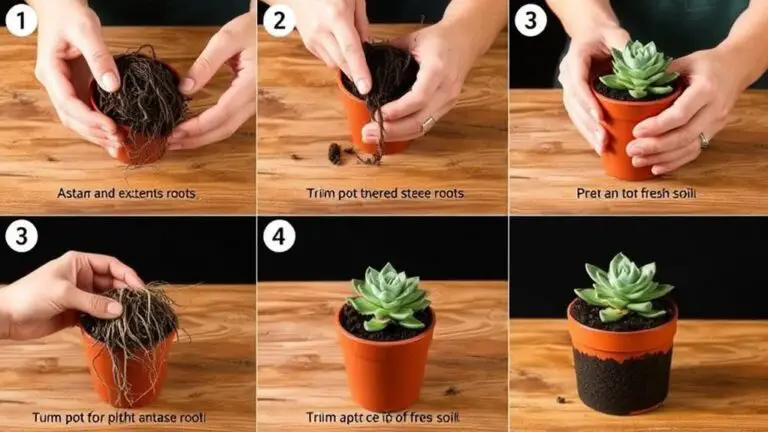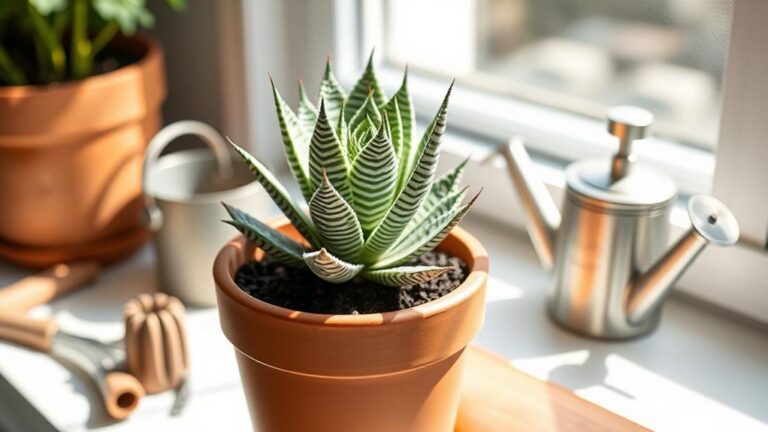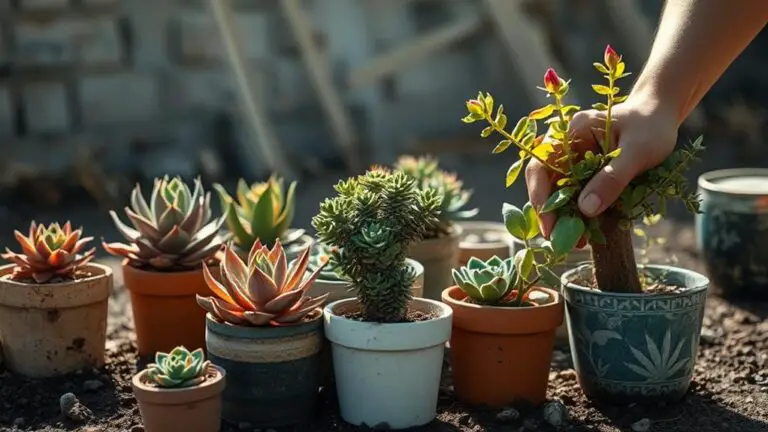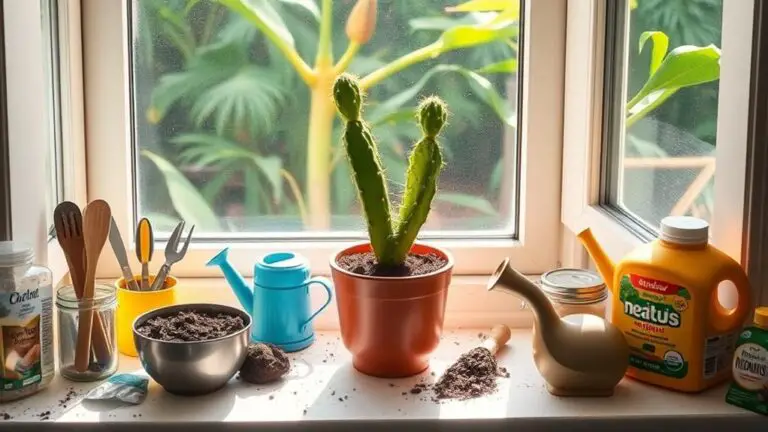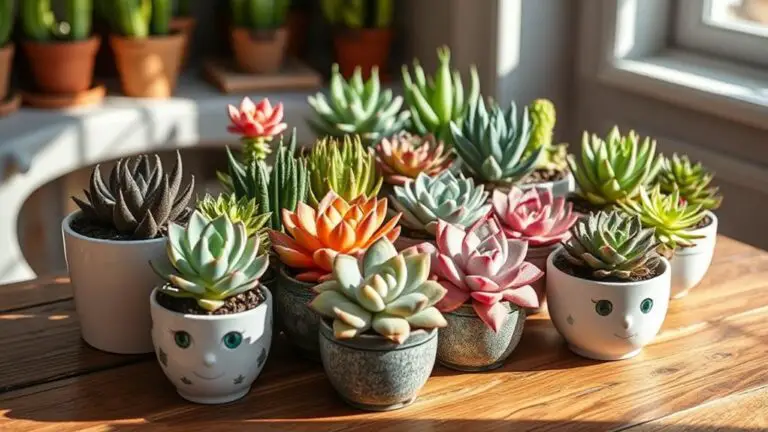How Air Circulation Helps Your Succulents Thrive
You've probably noticed that some succulents just seem to flourish while others struggle. One often overlooked factor is air circulation. By ensuring a steady flow of CO2, you can enhance photosynthesis, which promotes robust growth and strong root systems. Proper airflow also helps manage moisture levels, reducing the risk of root rot and fungal diseases. But that's not all—consistent air movement can deter pests and even strengthen your plants' structure. So, what exactly makes air circulation such a game-changer for your succulents? Let's explore the key elements that contribute to their thriving.
Enhances CO2 Levels
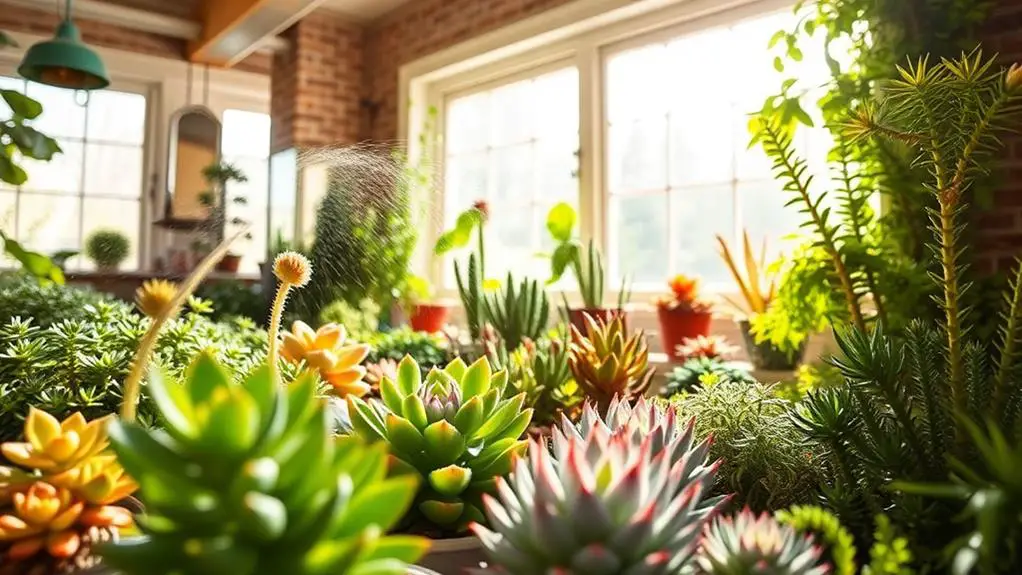
Good air circulation often enhances the CO2 levels around succulents, which is crucial for their photosynthesis and oxygen production. When you guarantee proper air movement, you're directly supporting your succulents' ability to grow and stay healthy.
Stagnant air can be a problem, leading to insufficient CO2 levels. This might cause your plants to experience slowed growth and reduced vigor.
By improving the air circulation, you make certain that CO2 is readily available to both the roots and leaves of your succulents. This enhances their overall health and promotes continuous growth.
Succulents thrive when they've access to plenty of CO2, as it's a key component in the process of photosynthesis. This process not only helps in producing oxygen but also in generating the energy your plants need to grow.
Enhanced CO2 levels from better air circulation contribute to stronger root systems. Strong roots mean that your succulents can absorb nutrients more effectively, preventing issues related to poor nutrient absorption.
Reduces Pest Infestation
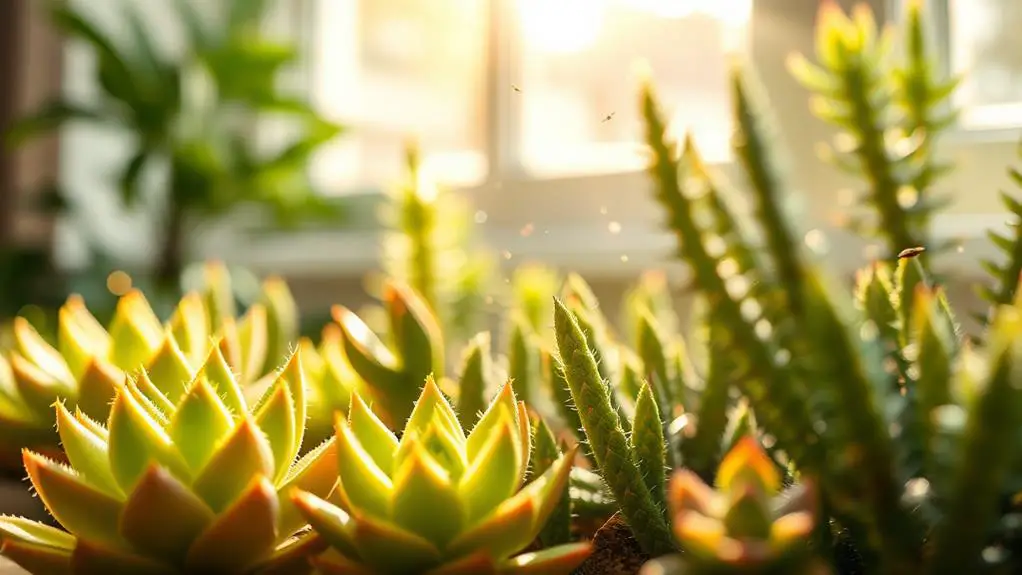
Proper air circulation is essential for keeping pests away from your succulents.
By preventing moisture from building up, you make your plants less attractive to pests like mealybugs and fungal gnats.
Keeping the air moving also helps dry the soil quickly, reducing the chances of overwatering and creating a less hospitable environment for pests.
Prevents Moisture Accumulation
By guaranteeing adequate air circulation around your succulents, you can effectively prevent moisture accumulation that often invites pest infestations. Good air circulation helps evaporate excess moisture from the soil surface, reducing the risk of root rot and promoting healthier succulents.
When air is stagnant, it increases humidity levels, creating an ideal environment for pests like fungal gnats and mealybugs to thrive. Positive airflow aids in drying out damp soil quickly. This prevents the conditions that attract mold and mildew, which can harm your succulents.
Regular air movement enhances transpiration in your plants, allowing for better nutrient absorption and reducing the likelihood of overwatering. Overwatering is a common issue that leads to moisture accumulation and, subsequently, to pest infestations.
Maintaining good airflow around your succulents not only discourages pest infestations but also promotes stronger, more resilient plant growth. By keeping the air moving, you guarantee that your succulents get the fresh air they need to stay healthy.
Deters Common Pests
When you guarantee your succulents have adequate air circulation, you drastically reduce the chances of pest infestations. Good air circulation lowers humidity levels, which deters moisture-loving pests like fungal gnats and mealybugs from thriving. Stagnant air, on the other hand, creates an inviting environment for these pests and diseases.
| Benefits of Air Circulation | Issues with Stagnant Air |
|---|---|
| Lowers humidity levels | High humidity levels |
| Reduces moisture buildup | Increases mold risk |
| Strengthens plants | Weakens plant health |
Fresh air circulation minimizes the risk of mold and mildew development. Regular airflow strengthens succulent stems and roots, making your plants more resilient against pest infestations and other stressors. By improving transpiration and nutrient absorption, adequate air circulation reduces the likelihood of overwatering, a common cause of pest problems.
Positioning your succulents in areas with natural airflow or using fans indoors promotes healthier plants. These plants are less prone to infestations and diseases, setting you up for success. So, don't underestimate the power of good air circulation; it's key to keeping your succulents happy and pest-free.
Improves Moisture Control
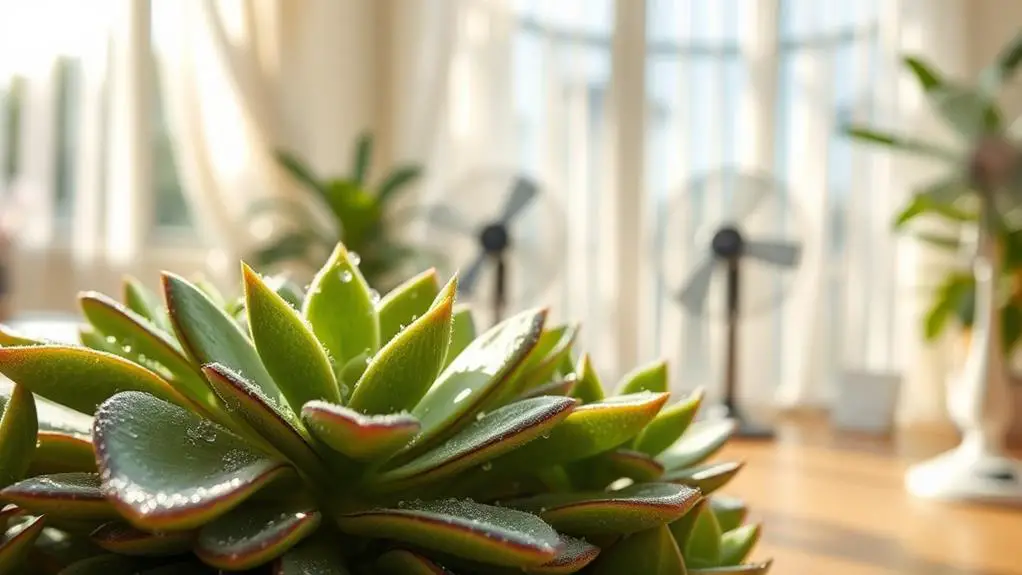
Good air circulation is key to keeping your succulents' soil from getting too wet, which can prevent root rot.
By allowing excess water to evaporate faster, you reduce the risk of mold and pests.
Proper airflow also helps maintain the right moisture balance, so your plants stay healthy and happy.
Prevents Overwatering Issues
Air circulation plays a pivotal role in preventing overwatering issues in succulents by improving moisture control. When air flows around your plants, it helps prevent excess moisture from building up in the soil, which can lead to root rot.
Succulents need good drainage to thrive, and proper air circulation guarantees that the soil dries out quickly after watering, reducing the risk of overwatering.
Stagnant air can create high humidity levels around your succulents, which isn't ideal. Fungal spores and pests love high humidity, and these can harm your plants.
By keeping the air moving, you're creating an environment where these problems are less likely to occur. This movement helps regulate humidity levels, keeping them just right for your succulents.
Good air circulation also improves nutrient absorption. As air moves, it enhances transpiration, allowing your plants to take in nutrients more effectively.
This means healthier, more vibrant succulents.
Reduces Mold Risk
Effective air circulation is vital in reducing mold risk around your succulents. When air helps move around your plants, it lowers humidity levels, making it harder for mold to grow. Stagnant air, on the other hand, creates a perfect environment for fungal spores. Ensuring adequate airflow keeps these risks at bay.
Healthy airflow around your succulents promotes faster drying of wet soil. This prevents excess moisture, which can lead to mold and root rot. Positioning your succulents near windows or using fans can provide consistent airflow, greatly lowering the chances of mold-related issues.
Air helps in another important way too. It enhances transpiration, which is how your succulents release excess moisture. This process maintains ideal humidity levels around their leaves, further discouraging mold growth.
Strengthens Plant Structure

With proper air circulation, succulents can develop stronger and more resilient structures. When you guarantee consistent airflow around your plants, it promotes healthy transpiration and enhances water uptake. This process helps build stronger root systems, crucial for supporting the plant's overall health and vigor.
Exposure to gentle breezes or wind stimulates thicker stem growth in your succulents. This thicker growth equips the plants to withstand various environmental stressors, such as sudden temperature changes or heavy rain. By providing consistent airflow, you prevent weak stems that could lead to poor growth and increased vulnerability to pests.
Good air circulation also encourages succulents to develop deeper and more robust root systems. These strong roots improve nutrient absorption, giving your plants the strength they need to thrive.
When succulents have stronger plant structures, they become more resilient and better equipped to handle different environmental conditions.
Incorporating proper air circulation into your plant care routine fosters overall plant vigor. Your succulents will grow healthier and more robust, reducing the likelihood of damage.
Prevents Fungal Diseases
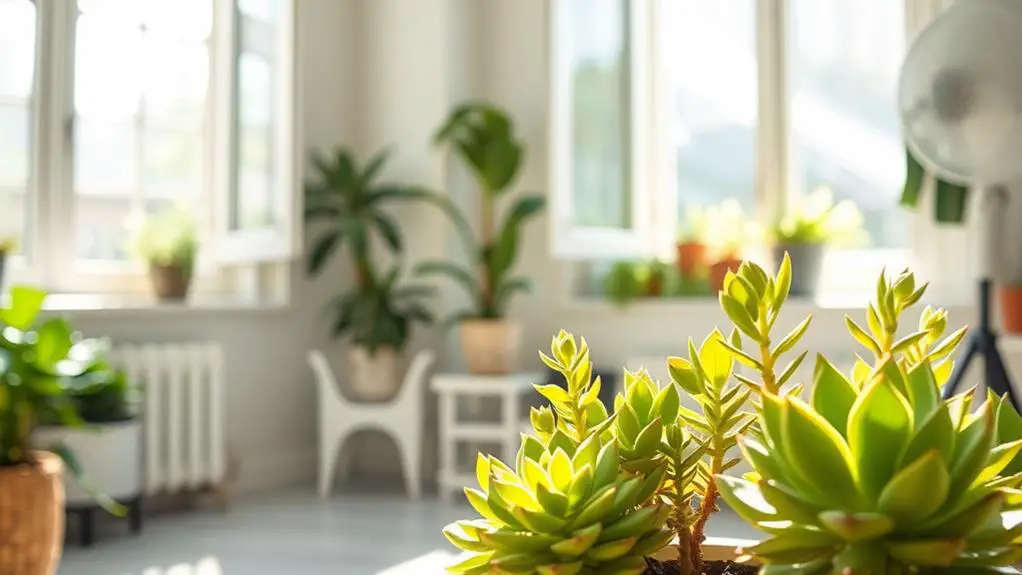
Not only does proper air circulation strengthen your succulents, but it also plays an important role in preventing fungal diseases. Good air circulation helps reduce humidity levels around your succulents, which is vital in preventing the growth of fungal spores that thrive in moist conditions.
When air is stagnant, it creates a breeding ground for mold and pests, making proper airflow essential for maintaining plant health and preventing diseases.
Wind and air movement promote transpiration, which aids in drying excess moisture from the soil and leaves. This reduces the risk of root rot and fungal infections.
By ensuring consistent airflow, you're not only helping your plants stay dry but also strengthening their structure, making them less susceptible to damage from fungal diseases and improving overall resilience.
Regularly inspecting your succulents in well-ventilated areas allows for early detection of potential fungal issues. This way, you can catch problems early and take action quickly.
Optimizes Growth Environment

Creating an ideal growth environment for your succulents hinges on proper air circulation, which directly impacts their health and development. Adequate air circulation guarantees your succulents get a continuous flow of CO2, enhancing photosynthesis. This process is essential for their growth and oxygen production.
Proper airflow also helps to prevent excessive humidity, reducing the risk of overwatering and root rot, which are common issues when air is stagnant. Wind exposure encourages thicker stem growth and deeper root systems, making your succulents more resilient to environmental stressors.
Good air circulation helps your soil dry quickly after watering, preventing the anaerobic conditions that can harm your succulent roots and impede nutrient absorption. Additionally, regular airflow can deter pests like fungal gnats and mealybugs by creating an environment unfriendly to their proliferation, supporting healthier plants.
Here are some key benefits of guaranteeing adequate air circulation for your succulents:
- Enhances photosynthesis by maintaining a steady CO2 flow.
- Reduces the risk of overwatering and root rot.
- Encourages thicker stems and deeper roots.
- Promotes quicker soil drying, preventing anaerobic conditions.
- Deters pests, supporting healthier plants.
Frequently Asked Questions
Do Succulents Need Air Flow?
Yes, your succulents need air flow. Good air circulation prevents moisture buildup, reducing the risk of pests and diseases. It helps the soil dry out faster, preventing root rot and promoting healthier, stronger plants.
What Makes Succulents Thrive?
To make your succulents thrive, guarantee they get 6-8 hours of bright, indirect light daily. Maintain ideal temperatures between 55°F and 75°F, use well-drained soil, follow a wet-dry watering cycle, and provide good air circulation.
How Do You Boost Succulent Growth?
To boost succulent growth, place them near windows or use fans for better air circulation. This prevents moisture buildup, strengthens stems, and enhances photosynthesis. Regularly clean leaves and guarantee balanced wind exposure for ideal growth.
How Do You Stimulate Succulents to Grow?
To stimulate your succulents to grow, give them bright, indirect light for at least 10 hours daily, water thoroughly but infrequently, provide good air circulation, use balanced fertilizer sparingly, and keep humidity levels low.
Conclusion
By ensuring good air circulation, you're giving your succulents the best chance to thrive. They'll get enough CO2 for photosynthesis, stay safe from pests, and avoid too much moisture. Your plants will grow stronger and be less likely to get sick from fungus. So, keep that air moving, and you'll see your succulents flourish! Remember, a little airflow goes a long way in creating the perfect environment for your green friends. You've got this!


